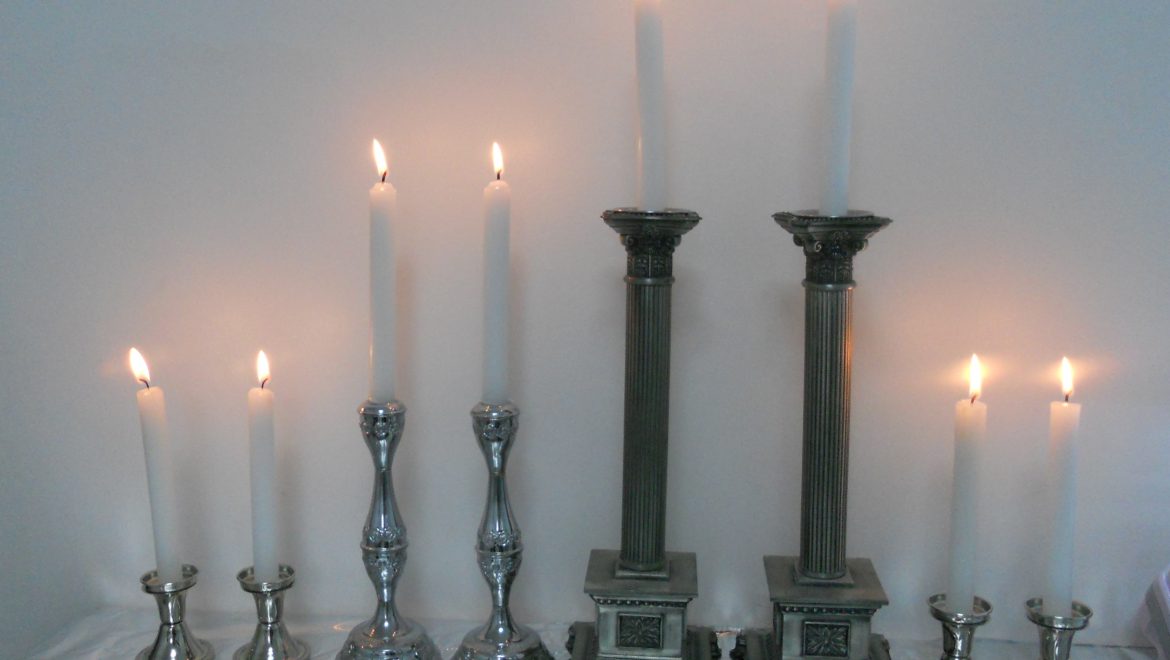
The following article briefly explains the basic structure of the candle lighting ceremony and some related customs, including the text of the blessing in Hebrew, English translation and transliteration. The post was written by Rabbi Howard Markose, a Jerusalem-based educator and former community rabbi who received rabbinical ordination from the Jewish Theological Seminary in New York.
Shabbat Candle Lighting: An Introduction
What?
The home rituals on Friday night begin just before the commencement of Shabbat with the kindling of the Shabbat candles. The candles, which can be in the form or wax candles or oil and wicks, are generally placed on any surface where they can be appreciated and used as light. While the source of this mitzvah (commandment) is not found in the Torah itself, due to its importance, the sages determined that lighting candles on Friday night would be designated a Torah command just the same.
When?
In the spirit of adding holiness to the most important day in the Jewish calendar week, the candles are kindled prior to sunset (traditionally 18 minutes before) and should remain burning for at least three hours. One should simply allow the candles to burn out by themselves, as opposed to extinguishing them.
How many?
Because the light provided by these candles is designed to bring joy (oneg) and harmony (shalom bayit) into the home, multiple candles are traditionally kindled. In most homes, two candles are lit, reminiscent of the two different calls to celebrate Shabbat found in the Jewish Bible: “Remember (zachor) the Shabbat day to keep it holy” (Exodus 20:8)’ and “Guard (shamor) the Shabbat day to keep it holy” (Deuteronomy 5:12). According to some traditions, unmarried people light only one candle, while some families choose to light an additional candle for each member of the family.
Who?
The mitzvah to kindle the Shabbat candles applies to men as well as to women equally, yet it is most commonly undertaken by women. Only one person in the household needs to recite the blessing, fulfilling the obligation for all who are gathered in celebration of Shabbat.
How?
The blessing can be sung, recited aloud, or whispered in solitary meditation. Others who are present are invited to proclaim ‘Amen’ following the recitation as if to say to the reciter, ‘I join you in this mitzvah!’
In the Ashkenazic tradition, the ritual of lighting the Shabbat candles unfolds as follows: First, the candles are lit. Then, the person reciting the blessing draws their hands to their face three times, as if they were beckoning the Shabbat Queen to come near (some say that it is to ‘take in’ the energy that is produced by the kindled lights). The person then covers their eyes with their hands (some simply close their eyes) and recites the blessing:
בָּרוּךְ אַתָּה אֲדֹנָי אֱלֹהֵינוּ מֶלֶךְ הָעוֹלָם אֲשֶׁׄר קִדְּשָׄנוּ בְּמִצְוֹתָיו וְצִוָּנוּ לְהַדְלִיק נֵר שֶׄל שַׄבָּת
Barukh ata Adonai, Eloheinu Melekh ha-olam, asher kidshanu bemitzvotav vitzivanu l’hadlik ner shel Shabbat.
Blessed are You, God, Ruler of the universe, who sanctified us with the commandment to light Shabbat candles.
Many people take a few minutes following the lighting of the candles and the recitation of the blessing to reflect or to utter personal prayers for the well being of the family (or anything else that comes to one’s mind and heart at this special moment). Others choose to add prayers or meditations prior to the kindling of the lights in order to produce a meaningful mood for this very proliferate mitzvah.

